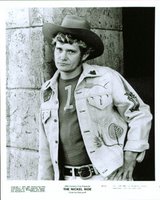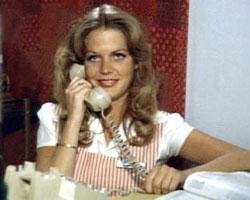
When
The Nickel Ride begins, Cooper is already feeling backed into a corner. He wakes up in the middle of the night thinking about the big deal that he's been trying to set up. But while his beautiful young girlfriend lies sleeping beside him at 4 AM, he sits in bed smoking a cigarette, thinking about that block. It seems like every time he nails down one corner, another comes undone. He needs all four pinned down at the same time to make this deal happen, but one look at his face tells you how long he's been trying to do just that. Cooper is a big fish in a small pond. His dream is tied up in one discreet block, his whole world a triangle that goes from his girl at home, to his downtown office, to the bar two doors down. Too bad for him his little pond sits smack dab in the middle of a tremendous ocean, and the bigger fish swimming around are bound to swallow him whole sooner or later, and in a movie like this, it's sure to be sooner.
There are several reasons to recommend Robert Mulligan's little-seen 1974 L.A. noir
The Nickel Ride, but the best one is the lead performance from the late Jason Miller. Today, most remember Miller most as Father Karras in
The Exorcist. He was also a Pulitzer Prize winning playwright ("That Championship Season"), an accomplished stage actor, and an underrated character actor on film. In
The Nickel Ride, he plays Cooper, a graying mid-level crime boss in downtown L.A. who "holds all the keys", a former carnival barker who made the short leap to organized crime a long time ago. He's trying to buy up a block of warehouses which he will use to fence stolen merchandise. If anyone's got something to hide away, Coop would be the man you need to see. The block is, appropriately, a dead end. Miller is phenomenal trying to keep it together while he watches his whole world slowly come apart. You see it in his eyes, in his physicality, and of course, in his need to get that morning belt before heading upstairs to do business. You wonder if what he's afraid of even exists at all. Maybe he's just losing his mind. But maybe he's not. Who knows? Miller doesn't tip his hand. The result is a great showcase for a great actor, and he's a pleasure to watch in it.
Another reason to watch is to see Bo Hopkins as Turner, a cowboy from Kansas City who's in town for more than just a southern California vacation. Hopkins is great as the tall, charming, but stone cold "country talker" who never seems to shut up.

The chemistry between Hopkins and Miller carries the middle part of the movie as we sit in on several suspensful rounds of a mental chess match built on mutual distrust. John Hillerman (Higgins from
Magnum P.I.) is the big boss, Carl, and Linda Haynes (
Rolling Thunder) is Sarah, Cooper's wide-eyed blonde girlfriend from West Virginia.
The movie was directed by Robert Mulligan, who came out of 50's tv and like several of his contemporaries, produced a long resume of professional, well remembered, award winning films, including
Fear Strikes Out,
To Kill A Mockingbird,
Baby the Rain Must Fall, and
Summer of '42. He is in some ways a perfect example of the "anti-auteur", the most obvious thread throughout his work being a lack of consistent themes. Still,
The Nickel Ride stands out from the bulk of his filmography with it's bleak, pessimistic tone. The film it most closely resembles is Peter Yates'
The Friends of Eddie Coyle, made a year before, in which Robert Mitchum plays a similarly predestined underworld tough. Like
Eddie Coyle,
The Nickel Ride is an actor's picture that benefits from great photography. Cinematographer Jordan Cronenweth would later act as DP for
Altered States,
Blade Runner, and
Stop Making Sense, but when he did
The Nickel Ride, he was still in the world of low-budget exploitation and genre work. His considerable talents are on display front and center here, especially in the leisurely first third of the film, which spends much time taking in the anonymous urban landscape these characters inhabit. The script was written by Eric Roth, today one of the most successful screenwriters in the business, with a long list of hits that includes last year's
Munich, as well as
Ali,
The Insider,
The Horse Whisperer, and
Forrest Gump. It's amazing that someone involved in that series of films could write something this interesting, but hey, in the 70's
anything was possible.
Unfortunately,
The Nickel Ride is unavailable on home video. It was released in 1975 by 20th Century Fox, didn't do well, and it's been obscure ever since. I'm not even sure if it was ever released on vhs. But the Fox Movie Channel does occasionally show a letterboxed print of it, and as of now, that's really your only way to catch this great little movie. Look for it, it'll be worth the effort.





